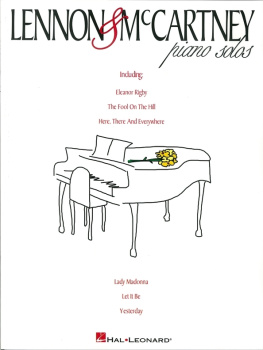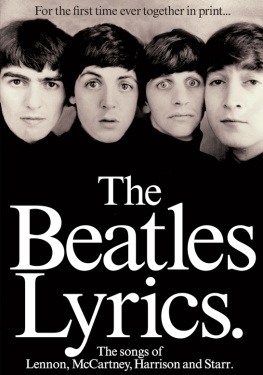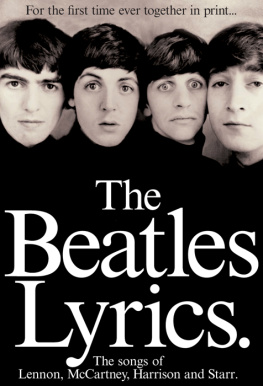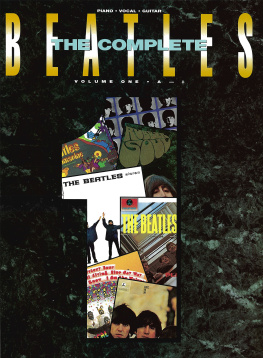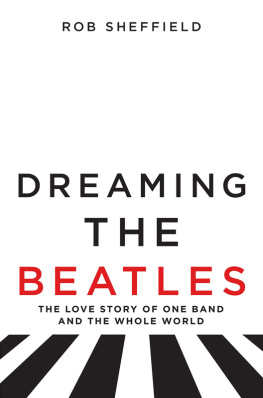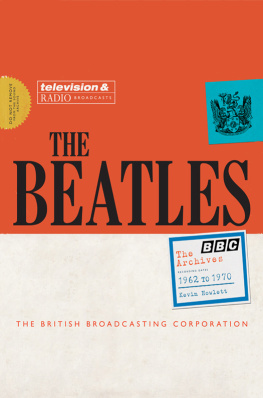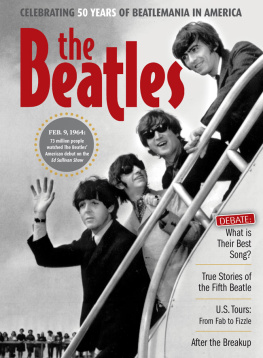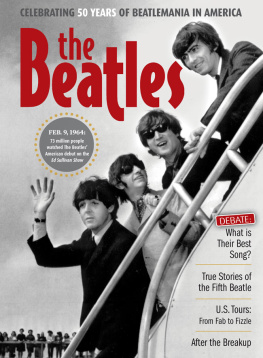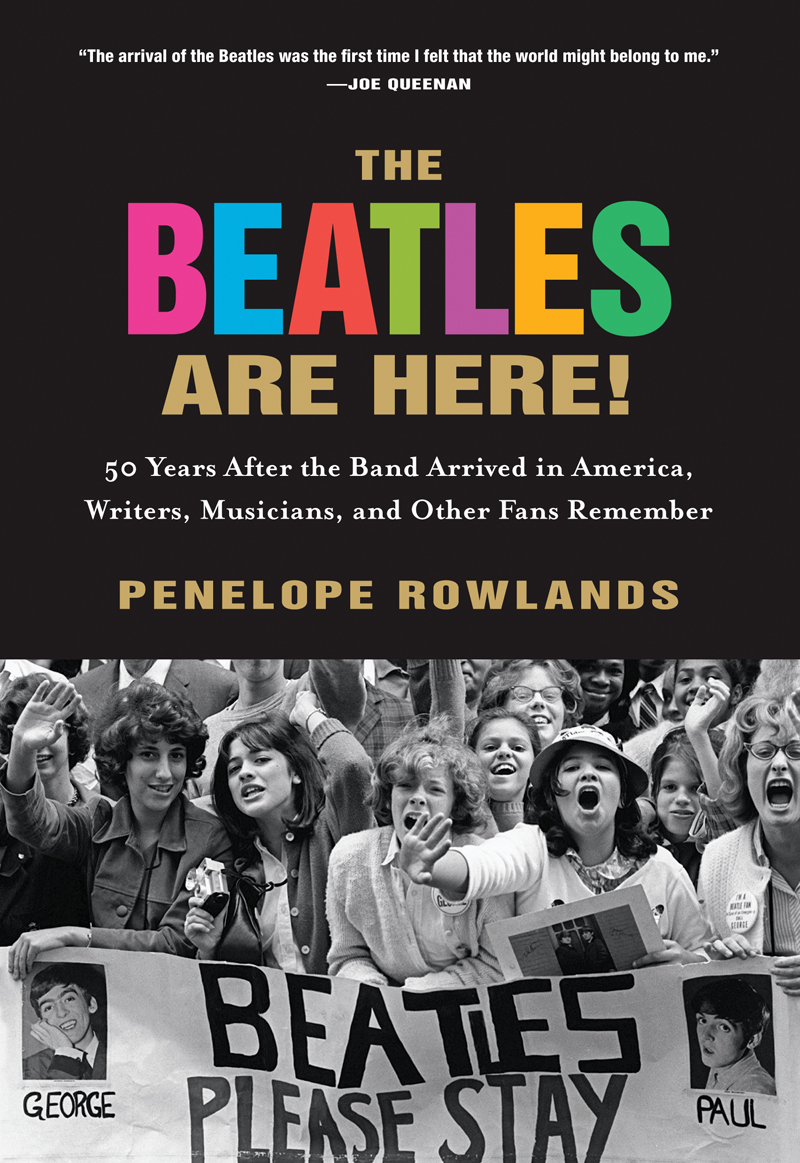The Beatles Are Here!
50 Years after the Band Arrived in America, Writers, Musicians, and Other Fans Remember
Edited by
PENELOPE ROWLANDS

ALGONQUIN BOOKS OF CHAPEL HILL 2014
Also by Penelope Rowlands
A NTHOLOGY
Paris Was Ours: 32 Writers Reflect on the City of Light
B IOGRAPHY
A Dash of Daring: Carmel Snow and Her Life in Fashion, Art, and Letters
M ONOGRAPHS
Jean Prouv: Visionary Humanist
Eileen Gray: Modern Alchemist
I LLUSTRATED BOOK
Weekend Houses (with photographer Mark Darley)
For Julian, always,
& for my sisters in screaming:
Vickie
Joann
Linda
All those beautiful songs that helped me exist...
CYNDI LAUPER
CONTENTS
INTRODUCTION
W E WERE THERE.
We were there when the Beatles first landed on American shores, half a century ago.
This book is about the impact of their arrival. It is a scrapbook of madness, in John Lennons famous words.
Our madness, and theirs.
People who werent around then can scarcely imagine how it was when the Beatles came. How quickly they changed... everything.
Suddenly, they were here. There. Everywhere. The band infiltrated the airwaves by way of AM radio, at first via just a few songs, including, notably, She Loves You, with its famous Yeah, yeah, yeah chorus and insistent, captivating beat. Two minutes and nineteen seconds that seemed to render almost everything, musically, that came before it obsolete.
It erased so much.
The world was so different thenas so many witnesses to the Beatles phenomenon attest in the following pages. The Atlantic seemed impossibly vast. There was no Internet, of course. News traveled by way of long-distance calls (rare because of the expense) and telegrams. Telegrams!
Beginning in late 1963 the songs arrived, ultrafast, delivered to us via quick-talking DJs and in vinyl form45s, EPs, LPs. Each album came in mono or stereo. Whatever the format, each Beatles song was a burst of fresh sound, with a danceable beat, sweet, easy lyrics. I can still recall how electrifiedshocked!I felt by the first one I ever heard; from its thrilling opening drum roll to its curious last chord, She Loves You took me somewhere else.
One release followed another in staccato successionI Want to Hold Your Hand, Love Me Do, I Feel Fine, Eight Days a Weeka sustained climax that went on and on. Which partly explains the intensity of the experience. Within a quick slice of time the band changed the way we dressed, moved, listened, thought. The way we were.
One writer in these pages, Sigrid Nunez, likens the experience of Beatlemania to drinking a potion. It was that transformative and abrupt. Joe Queenan describes a revolution: The Beatles swept away Pat Boone, Vic Damone, the Kingston Trio, doo-wop, and all that other twaddle in about thirty-six hours.
We carried around the Beatles songs on plastic transistor radios with their scratchy sound. We moved to the music. We came alive to it on boardwalks down the shore in New Jersey; in sleepy Southern towns; on farms in Oregon; in Detroit cityscapes. We blared it out to our American world from streamlined, finned, gas-guzzling cars; suburban houses with pristine lawns; urban apartments overlooking sooty alleys. And some of us heard it in our heads as we chased the Beatles down hotel corridors or yelled up to them from the sidewalks below.
We were so primed to scream. As quite a few people in this collection, including Cousin Brucie Morrow, the legendary disc jockey, and the musician Billy Joel, remind us, the bands arrival in February of 1964 seemed to awaken this country from a profound, shattering grief. President Kennedy had been assassinated only six weeks before. America was in shards.
I remember coming home from school through the streets of Manhattan on the day JFK was killed, walking among hollow-eyed, tear-stricken adults. Grown-ups who had apparently emerged from a black-and-white horror film, lurching along, as if barely alive themselves.
Within a few short months, I was running through those same New York streets with a pack of girls I scarcely knew, following the Beatles and other British rock and roll bands around town, shrieking at the top of our lungs.
Which is how The Beatles Are Here! came about. Many years after the photograph on the cover of this book was published in the New York Times, I wrote about both that image and my Beatlemaniac years for Vogue. Several years later, the girls in the picture (actually, all but one) found one another again. We had stood side by side almost fifty years earlier on a sunny city street, fellow Beatlemaniacs, united in screaming. When we met again, through miraculous, Internet-era kismet, we felt a bond.
One that endures to this day.
Our story, among so many others, threads through this collection. It is our scrapbook of madness, comprised of written essays, interviews (the two can be distinguished in the pages that follow by the icons before each one: a microphone for interviews, a pen for written texts), and other fragmentsincluding an email, a Facebook exchange, a handwritten diary entry. Some of the voices here are famous, others are not, but all touch on how profoundly affected we were by the arrival of the Beatles in our midst. And by we, I dont mean just those who experienced them firsthand: a few of these contributors werent even born when the band tore into town. Yet they, too, experienced them vividly, if at some remove.
One person after another bears witness to a cultural event so enormous that its hard to imagine an equivalent. The writer Verlyn Klinkenborg exultscounterintuitively, at the very leastover not attending a performance of the band he revered when they played near his California town. For Vronique Vienne, a Frenchwoman who came to live in New York City just when the Beatles arrived, the group provided a soundtrack to a strange and surreal-seeming way of life.
Singer Cyndi Lauper, standing distractedly by a highway near Kennedy Airport, missed seeing the bands limousine as it roared by. No matter. Ringo, John, Paul, and George were omnipresent in her bedroom in a nearby Queens neighborhood in the fan photos shed taped, adoringly, to the walls. Its tempting to believe that, even in two-dimensional form, they asserted their power, awakening this future superstar to love and music.
They did the same for so many of us.
For me, as this books editor, culling this material was a quiet education, instructive in countless ways. It was fascinating to see how often disparate narratives aligned with each other, then diverged. And I was intrigued to learn from a host of musicians why the Beatles music was so powerful thenand remains so to this day.
The singer and songwriter Janis Ian explains precisely how that chord works, the one that sends chills down our spines at the beginning of A Hard Days Night. The glorious soprano Rene Fleming, who has recorded her own stunning, dusky rendition of the Lennon-McCartney ballad In My Life, marvels at the perspicacity of the Beatles lyrics, as does the omnitalented young composer and songwriter Gabriel Kahane. And musician Tom Rush takes us poignantly back to the moment when folk music was the unlikely center of popular radio culture. It was doomed, of course. It was soon to be engulfed by you-know-who and the clamorous rockers that came after.


